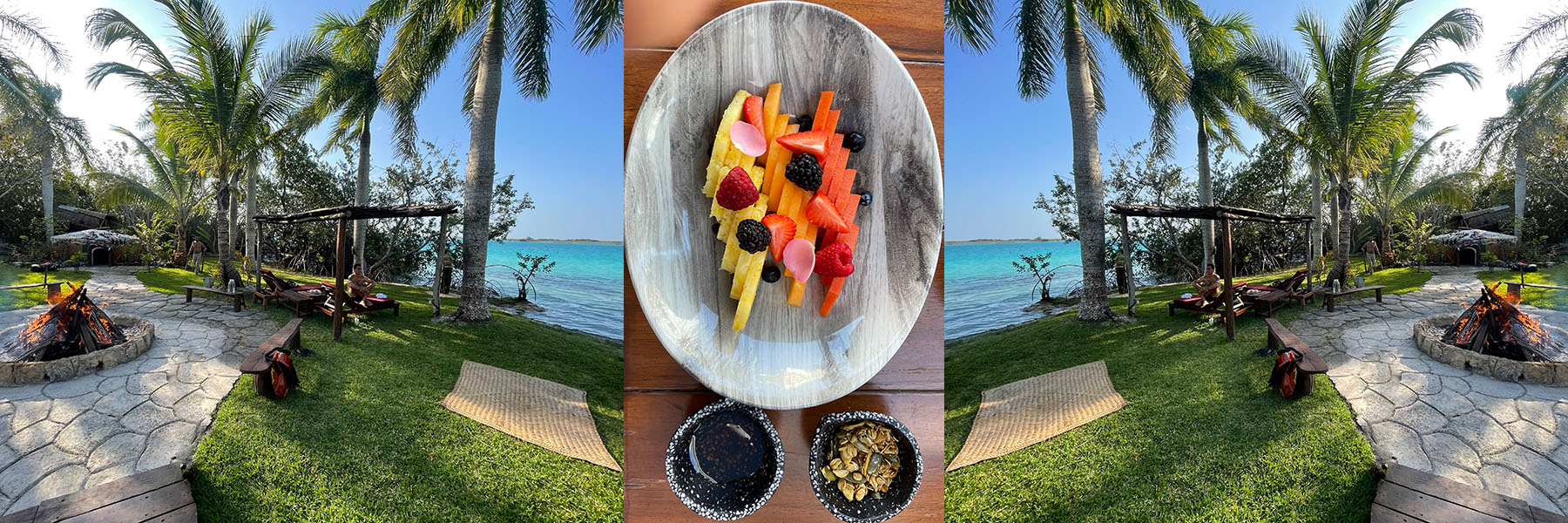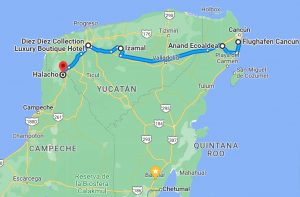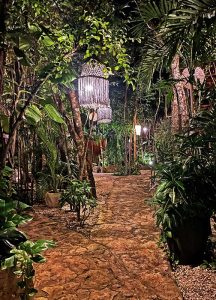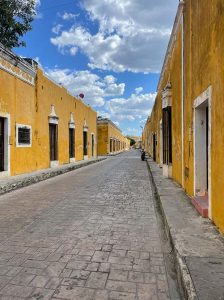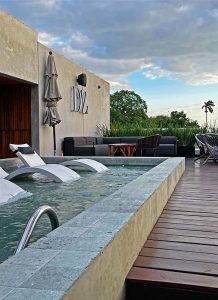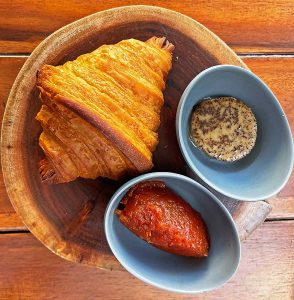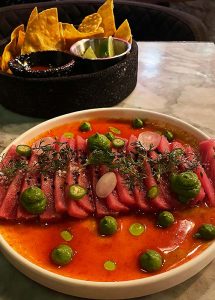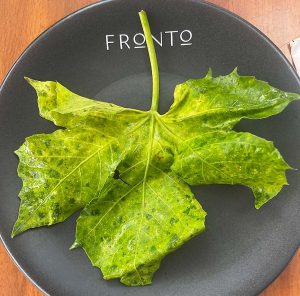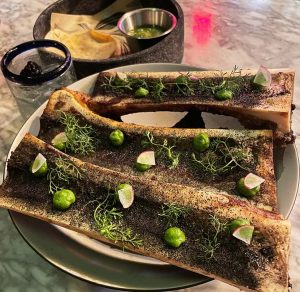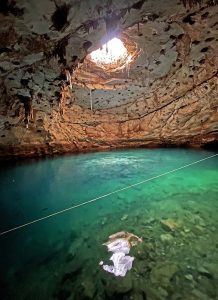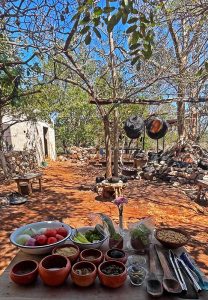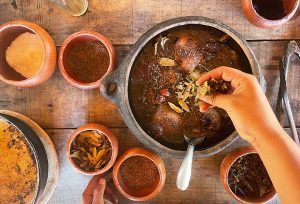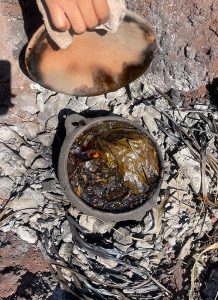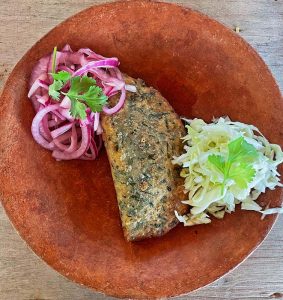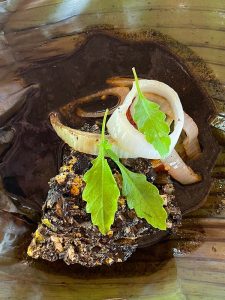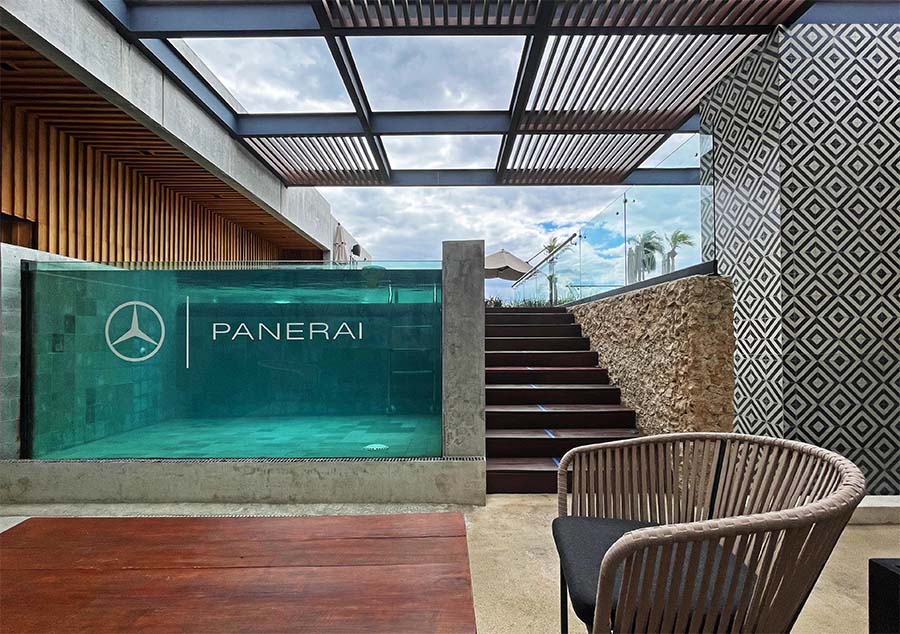Reisebericht: Yucatán, Mexiko – Teil 1
15.08.2023
Lässt sich Mexiko nur noch an der Pazifikküste genießen, fernab vom amerikanisierten Tourismus der karibischen Strände ?
Diese weit verbreitete Einschätzung zu widerlegen war der ursprüngliche Anlass zu dieser Reise nach Yucatan. Ich hatte 10 Tage Zeit, ein mir bis dahin noch unbekanntes Fleckchen Erde zu bereisen, hatte Lust auf Abenteuer, Kultur, und natürlich spielte auch gutes Essen bei der Auswahl eine entscheidende Rolle.
Der Vorteil, den der Tourismusboom auf der Halbinsel mit sich bringt, ist die bestehende und gut funktionierende Infrastruktur. Denn dadurch war gewährleistet, dass wir in 10 Tagen viel erkunden konnten, ohne für 300 km Strecke einen kompletten Reisetag einzuplanen zu müssen oder 2 Tage in der Pampa zu hocken, um auf den nächsten Bus ins nächste Dorf zu warten. Und wenn man den Beachtrip von Cancún bis runter nach Tulum, dem ehemaligen verwunschenen Hippiedorf, vermeidet, das heute eher einer Partymeile gleicht , so findet man wunderschöne Orte und kann einen wundervoll abwechslungsreichen Urlaub erleben, bei dem von allem etwas dabei ist.
Also Mietauto abgeholt und los ging es.
Erster Stopp – Merida
Zunächst in Richtung Westen nach Mérida, der Hauptstadt Yucatáns. Dort hatten wir in einem kleinen, sehr versteckten und besonderen Hotel reserviert. In Cancún selbst gibt es hauptsächlich die großen amerikanischen Hotelketten, jedoch wollte ich aufwachen und mich bereits fern fühlen, und nicht im standardisierten Hotelzimmer. So schliefen wir die erste Nacht in einem Baumhaus im Dschungel. Eine Mischung aus Hostel, mit Küche zum Selbstkochen, und Hotel, wird man hier morgens von den vielfältigen Geräuschen der Tiere des Dschungels geweckt. Surreal nach 16 Stunden Flug. Anand Eco Aldea – Eco Aldea
Kurz vor Mérida liegt eine kleine Stadt, Izamal. Todo amarillo (Alles gelb). Gelb, zu Ehren der Sonne und des Mais. Beides für Mexiko sehr wichtig. Hier lassen sich auch die spanischen Einflüsse im Baustil der Gebäude und des innenstädtischen Klosters erkennen. Ein charmanter Zwischenstopp.
Wärmsten zu empfehlen ist das zentral gelegene Boutique-Hotel, das Diez Diez Collection Luxury Boutique Hotel. Der diskrete, sehr zuvorkommende Service schafft eine ruhige, relaxte Atmosphäre. Bereits beim Frühstück erfreuten mich die kleinen Details : wirklich alles ist hier selbst gemacht, trotz der überschaubaren, täglich zuzubereitenden Mengen.
Hier wird spürbar keine Mühe gescheut. Zum selbstgebackenen Sauerteigbrot wird eine mit Kaffee versetzte Butter gereicht, welche noch vor dem Gast mit einem Bunsenbrenner karamellisiert wird, dazu gibt es hausgemachte Papaya-Marmelade.
Die selbst gebackene Zimtschnecke ist perfekt: matschig, leichte Hefenote, und doch mit etwas Textur.
Restaurant Fronto
Das kulinarische Konzept des Hotelrestaurants wurde von einem der anerkanntesten mexikanischen Köche, ROBERTO SOLIS, gestaltet, dem man nachsagt, er habe das Fine-Dining nach Merida gebracht. Und so überzeugte mich bereits das oben beschriebene Frühstück, hier, im Restaurant FRONTO, ein paar Tage später auch meinen Geburtstag zu feiern.
Mit herrlichen, schmackhaften und gut inszenierten Cocktails starten wir in den Abend.
Es folgt ein Thunfisch-Tiradito, die an ein Carpaccio erinnernde Variante eines Ceviches, begleitet von einer leche de tigre, dem milchigen Zitronen-Sud, welcher durch das Marinieren des rohen Fisches entsteht, mit Chile Guajillo, einer Chilisorte mit stark fruchtigem Geschmack und feiner Beerennote.
Dazu Guacamole und eine Koriander-Emulsion.
Die Variation von Tostones, ein “Taco” aus frittierter Kochbanane, – dieser mit knusprig saftigem Schweinebauch und mojo cubano, einer kubanischen Marinade aus Knoblauch, Bitterorange, Zwiebel und frischen Kräutern – und den Tacos – mit einem Salat aus Chaya (Baumspinat), dessen Blätter in der yucatekischen Küche vielfältig Verwendung finden, mit geriebenem, gealtertem Käse – sind spannend und eine erfreuliche Abwechslung zu den doch sehr ähnlich schmeckenden Tacos auf der Straße.
Die Tuetanos al carbon – Markknochen aus dem Feuer, bestreut mit der Asche aus Zwiebeln und betupft mit einer Emulsion aus grünem Chili, dazu natürlich Tortillas. Increíble, wenn man es denn mag. Dazu ein Pastel de Choclo, ein traditioneller Mais-Auflauf, hier jedoch als Gratin mit Brie und Rosmarin und am Tisch flambiert mit Mezcal. Toll!
Funfact: Alle Tequilas sind Mezcals!
Mezcal ist eine Spirituose, die aus Agaven gemacht wird. Tequila ist nur eine besondere Art von Mezcal, die ausschließlich aus 100% Blue Weber Agave hergestellt wird.
Cenotes
Merida selbst liegt nicht am Meer und ist auch weniger tropisch als der östliche Teil der Halbinsel.
Erfrischung suchen die Einwohner hier in den Cenotes: Kalksteinhöhlen mit Süßwasserpools.
Denn Yucatan ist durchzogen vom vermutlich größten zusammenhängenden Unterwasserhöhlensystem der Erde.
Es gibt offene Cenotes, die mehr an einen See erinnern, halb geöffnete, also tiefe offene Löcher, in die oft Pflanzen hineinragen, bis hin zu fast komplett geschlossenen, die man nur durch ein klitzekleinen Spalt erreichen kann.
Das Wasser hat oft eine stechend blaue Farbe, ist klar, kalt und oftmals sehr tief. Hier wurden schon Maya-Schätze gefunden und daher werden sie auch als heilig erachtet.
Kochkurs
Zu meinen Lieblingsaktivitäten in fernen Ländern, wie könnte es anders sein, gehört der Besuch eines Kochkurses. Denn hier lernt man aus erster Hand die verschiedenen Methoden, Zutaten und Geschmäcker kennen und zu unterscheiden und kann das Wissen um die eine oder andere Fertigungstechnik oder Geschmackskomponente mit nach Hause nehmen.
Der Kochkurs, organisiert durch Chef Wilson und sein Team (muss ich nochmal raussuchen), fand etwa 1,5 Stunden südöstlich von Merida statt, also mitten in der Pampa.
Eine etwas rustikale, aber liebevoll hergerichtete Kochlandschaft, begleitet von Hühnergackern, mit unterschiedlichen Stationen: Waschen, Schneiden, Kochen, Grillen und dem Erdofen zum Schmoren.
Bei dieser sehr ursprünglichen Kochtechnik, welche in vielen lateinamerikanischen Kulturen zu finden ist, wird das Essen im Topf oder einfach nur mit Bananenblättern umwickelt im Boden mit Steinen und Brennholz angezündet mit Erde verbuddelt und so langsam gekocht. Diese Zubereitung ist in Yucatán noch weit verbreitet, insbesondere bei Festen, also wenn für viele Menschen gleichzeitig warme Speisen zubereitet werden müssen.
Das von uns zu erlernende und zuzubereitende Menü bestand aus:
1. Empanadas mit Chaya und Frischkäse.
Chaya ist wie bereits erwähnt, eine Pflanze, welche geschmacklich an Spinat erinnert und als Superfood der Maya gilt. Weit verbreitet in der herzhaften Küche, wird Chaya auch Fruchtsäften als Vitamin-Lieferant beigemischt.
2. Sopa de Lima – überraschend erfrischende Hühnersuppe, auch bei über 30 Grad, aufgrund der geschmacklich dominanten Limette. Serviert wird diese mit frittierten Tortillastreifen, für etwas Textur.
3. Relleno Negro Pollo Piibil – im Erdofen geschmortes und in Bananenblatt gewickeltes Hühnchen mit Gewürzen wie Pfeffer, Nelken, Kreuzkümmel, geröstetem Knoblauch und Zwiebeln, sowie schwarz verkohlten Chilischoten, durch die das Gericht seine schwarze Farbe erhält.
Ein nettes Team, ein schöner, authentischer Ort. Und ich habe viel gelernt über Zutaten, Kochtechniken und Traditionen.
Beim Kochen kann man so viel über Land und Menschen erfahren, dass ich solch ein Erlebnis wirklich jedem ans Herz legen möchte.
Hier noch weitere Bilder aus unserer Bildergalerie:
english
Travel Report: Yucatán, Mexico – Part 1
Can Mexico only be enjoyed on the Pacific coast, far away from the Americanized tourism of the Caribbean beaches?
The original reason for this trip to Yucatan was to rebut this widespread prejudice. I had 10 days to travel to a part of the world that was unknown to me.
I was in the mood for adventure, culture, and of course good food also played a decisive role in the selection.
The advantage the tourism boom has brought to the peninsula is the existing and well-functioning infrastructure. This ensured that we could explore a lot within only 10 days. No need to plan a full day of travelling for merely 300 km or being suck in the middle of nowhere for 2 days to wait for the next bus to arrive. And if you avoid the beach strip from Cancún down to Tulum, the former enchanted hippie village, which today resembles an adult amusement parc, you discover beautiful places and can experience a perfectly varied holiday with a bit of everything.
So, we only picked up rental car at the airport and off we went.
First stop – Merida
First heading west to Mérida, the capital of the Yucatán.
There we had booked a small, very hidden and special hotel.
In Cancún itself, you mainly find the big American hotel chains, but I lusted to wake up and already feel far away, not in a standardised hotel room.
Thus, we slept the first night in a tree house in the jungle. A mixture of hostel, with kitchen for self-cooking, and hotel, we woke up to the varied sounds of the jungle animals. Surreal after a 16 hour flight.
Just before Mérida lies a small town, Izamal. Todo amarillo (All yellow).
Yellow, in honor of the sun and corn.
Both very important for Mexico. Here you can also see the Spanish influences in the architectural style of the buildings and the inner-city monastery. A charming stopover.
Highly recommended is the centrally located boutique hotel, Diez Diez Collection Luxury Boutique Hotel.
The discreet, very courteous service creates a quiet, very relaxed atmosphere.
Also at breakfast, I was delighted by the small but fine details: everything is homemade here, despite the manageable quantities that have to be prepared every day.
Noticeably no effort is spared. To the home-baked sourdough bread a butter mixed with coffee is served that is caramelized at the table as well as a home-made papaya jam. The fresh and homemade cinnamon roll is also perfect: mushy, slightly yeasty, and yet some texture.
Restaurant Fronto
The culinary concept of the hotel restaurant was created by one of the most recognized Mexican chefs, ROBERTO SOLIS, who is said to have brought fine dining to Merida.
Alone the breakfast described above convinced me to celebrate my birthday here, in the Fronto restaurant.
We start the evening with delicious, tasty and well-presented cocktails.
This is followed by a tuna tiradito, a variant of ceviche reminiscent of carpaccio, accompanied by a leche de tigre, the milky lemon juice obtained by marinating the raw fish, served with chile guajillo, a type of chilli with a strong fruity flavour and fine berry note. Served with guacamole and a coriander emulsion.
The variation of Tostones, a fried plantain „taco“ – the one with crispy juicy pork belly and mojo cubano, a Cuban marinade of garlic, bitter orange, onion and fresh herbs – and the tacos – with a chaya (tree spinach) salad, whose leaves have a variety of uses in Yucatecan cuisine, with shredded aged cheese — are exciting and a welcoming change to the tacos down the street.
The tuetanos al carbon – marrow bones from the fire, sprinkled with onion ash and dabbed with a green chili emulsion, served with tortillas, what else. Increíble, if you like it. Furthermore, we also order the pastel de choclo, a traditional corn casserole, here prepared as a gratin with brie and rosemary and flambéed with mezcal at the table.
Great!
Fun fact: All tequilas are mezcals.
Mezcal is a spirit made from agave. Tequila is just a special type of mezcal made exclusively from 100% Weber blue agave.
Cenotes
Merida itself is not on the sea and is also less tropical than the eastern part of the peninsula.
The inhabitants look for refreshment here in the „cenotes“.
Limestone caves with freshwater pools.
Because Yucatan is traversed by what is probably the largest interconnected underwater cave system on earth.
There are open cenotes that are more reminiscent of a lake, half-open, i.e. deep open holes, into which plants often protrude, to almost completely closed ones, which can only be reached through a tiny gap.
The water is often a pungent blue color: clear, cold and often very deep.
Mayan treasures have been found here and they are therefore considered sacred.
Cooking Course
One of my favorite things to do in country far away, how could it be any different, is to attend a cooking class. Because here you get to know and distinguish between the different methods, ingredients and tastes first-hand, and you can take the knowledge about one or the other production technique or taste component back home with you.
The cooking course, organized by Chef WILSON and his team, took place about 1.5 hours south-east of Merida, in the middle of nowhere.
A somewhat rustic but lovingly prepared cooking landscape, accompanied by cackling chickens, with different stations: washing, cutting, cooking, grilling and the earth oven for stewing.
With this very original cooking technique, which can be found in many LATIN AMERICAN cultures, the food is wrapped in a pot or simply in banana leaves in the ground with stones and firewood and buried with earth and cooked slowly underneath. This preparation is still widespread in the Yucatán, especially at festivals, i.e. when hot food has to be prepared for many people at the same time.
The menu to be learned and prepared by us consisted of:
1. Empanadas with chaya and cream cheese. As already mentioned, chaya, as mentioned before, is a plant that tastes like spinach and is considered a superfood by the Maya.
Widely used in hearty cuisine, chaya is also added to fruit juices as a source of vitamins.
2. Sopa de Lima – surprisingly refreshing chicken soup, even at over 30 degrees, due to the dominant taste of lime. Served with fried tortilla strips for some texture.
3. Relleno Negro Pollo Piibil – Earth oven roasted chicken wrapped in banana leaf with spices like pepper, cloves, cumin, roasted garlic and onion, plus chili peppers charred black to give the dish its black colour.
A nice team, a nice, authentic place and learned a lot about ingredients, cooking techniques, traditions. You can learn so much about the country, people and traditions while cooking, that I would really recommend such an experience to everyone.
More pictures can be found here in our photo gallery:
Author: Josefine Kammerer
Josefine Kammerer arbeitet bei einem Incubator von Unternehmen in Berlin und ist Besitzer des neuen israelischen Restaurants AVIV 030 in Berlin-Neukölln. Während eines Sabbatical besuchte sie eine Kochschule in Südamerika und betätigt sich in Berlin als Foodguide für das online Kulturmagazin kultur24.berlin.


